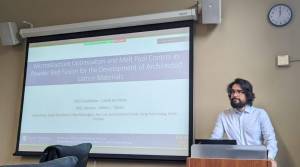 Congratulations to Dr. Caleb Andrews on successfully defending his thesis on August 10th, 2023! His doctoral project, entitled “Microstructure Optimization and Melt Pool Control in Powder Bed Fusion for the Development of Architected Lattice Materials”, demonstrates the ability to use advanced technology to control microstructures dynamically through process control. Check out his abstract, below! Congratulations, Caleb! We can’t wait to see what you do next.
Congratulations to Dr. Caleb Andrews on successfully defending his thesis on August 10th, 2023! His doctoral project, entitled “Microstructure Optimization and Melt Pool Control in Powder Bed Fusion for the Development of Architected Lattice Materials”, demonstrates the ability to use advanced technology to control microstructures dynamically through process control. Check out his abstract, below! Congratulations, Caleb! We can’t wait to see what you do next.
Abstract:
Powder bed fusion (PBF) technologies enable the manufacture of complex, interconnected, geometries and manufacture of metallic microlattice (MML) materials. Lattice materials and the principals of topological optimization behind them rely on the precise manufacture of interconnected networks of nodes and struts, the local geometry and arrangement of which can be optimized across scale to obtain desired properties – not unlike a crystalline lattice. This allows for the local engineering of material properties through topological control, but manufacturing these repeatably and validating their production remains a challenge. The melting and solidification environment within PBF techniques, using either laser (PBF-LB) or electron (PBF-EB) beams, is complex but generally characterized by melt pool volatility and high thermal gradients which can lead to high residual strains, anisotropic properties, and undesirable microstructures. These defects will often vary spatially across the volume of a part, meaning the lattice properties will be difficult to predict, are inhomogeneous, and not match the designed performance criterium. Therefore, this thesis aims to understand the complex solidification environments of these two PBF technologies, PBF-LB and PBF-EB, better characterize the types of microstructures they produce over Ti-based and Inconel alloy systems, and ultimately describe how through tailoring of process parameters better control of the microstructure of the material can be achieved. Critically, towards the application of lattice materials, this means the microstructure of the material can be tailored in addition to its topology.
Through intelligent design of scan strategy coupled with real-time melt pool monitoring, we demonstrate the ability to use these technologies to control microstructures dynamically through process control. By researching the solidification mechanisms at play with PBF technologies through a combined simulation, process monitoring, and high-resolution electron microscopy, a deeper understanding of the PBF process is obtained. Highlighting that while the AM melting environment can be volatile and highly variable, it is ultimately tunable and tailorable to engineer the microstructure temporospatially across the PBF process. This research has significant applications towards, and examples of, the manufacture of MML materials, and focuses on how this tuneability can be used to induce localized changes to solidification conditions within a lattice such that the microstructure is another dimension of control within these materials. By examining this process-properties feedback loop across scale, this thesis identifies how to close critical gaps in realizing robust and repeatable AM production and posits that melt pool and microstructure control is a necessary component in obtaining that goal.

